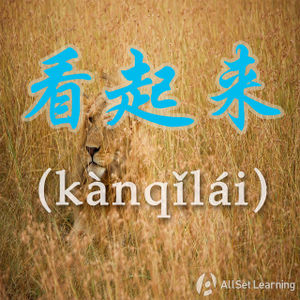Difference between revisions of "Appearance with "kanqilai""
m (Text replacement - "Zhè gè" to "Zhè ge") |
|||
| Line 1: | Line 1: | ||
{{Grammar Box}} | {{Grammar Box}} | ||
| − | One of the most common ways to express "it looks like" is to use 看起来 (kànqǐlái). This is what we would use if we wanted to express something like " | + | One of the most common ways to express "it looks like" is to use 看起来 (kànqǐlái). This is what we would use if we wanted to express something like, "she looks tired." |
== Structure == | == Structure == | ||
| Line 15: | Line 15: | ||
The subject can be omitted, in which case 看起来 can be followed with a whole statement. | The subject can be omitted, in which case 看起来 can be followed with a whole statement. | ||
| − | + | == Examples == | |
<div class="liju"> | <div class="liju"> | ||
| Line 21: | Line 21: | ||
* 这 个 <em>看 起来</em> 很 漂亮。<span class="pinyin">Zhè ge <em>kàn qǐlái</em> hěn piàoliang.</span><span class="trans">This looks very pretty.</span> | * 这 个 <em>看 起来</em> 很 漂亮。<span class="pinyin">Zhè ge <em>kàn qǐlái</em> hěn piàoliang.</span><span class="trans">This looks very pretty.</span> | ||
* 他 <em>看 起来</em> 很 友好。<span class="pinyin">Tā <em>kàn qǐlái</em> hěn yǒuhǎo.</span><span class="trans">He looks friendly.</span> | * 他 <em>看 起来</em> 很 友好。<span class="pinyin">Tā <em>kàn qǐlái</em> hěn yǒuhǎo.</span><span class="trans">He looks friendly.</span> | ||
| − | * 这 | + | * 这 个 蛋糕 <em>看 起来</em> 很 好吃。<span class="pinyin">Zhè ge dàngāo <em>kàn qǐlái</em> hěn hǎochī.</span><span class="trans">This cake looks really tasty.</span> |
* 你 今天 <em>看 起来</em> 很 累。<span class="pinyin">Nǐ jīntiān <em>kàn qǐlái</em> hěn lèi.</span><span class="trans">You look really tired today.</span> | * 你 今天 <em>看 起来</em> 很 累。<span class="pinyin">Nǐ jīntiān <em>kàn qǐlái</em> hěn lèi.</span><span class="trans">You look really tired today.</span> | ||
* 这 家 餐厅 <em>看 起来</em> 不错。<span class="pinyin">Zhè jiā cāntīng <em>kàn qǐlái</em> bùcuò.</span><span class="trans">This restaurant looks good.</span> | * 这 家 餐厅 <em>看 起来</em> 不错。<span class="pinyin">Zhè jiā cāntīng <em>kàn qǐlái</em> bùcuò.</span><span class="trans">This restaurant looks good.</span> | ||
Revision as of 03:29, 29 October 2015
-
Level
-
Similar to
-
Used for
-
Keywords
One of the most common ways to express "it looks like" is to use 看起来 (kànqǐlái). This is what we would use if we wanted to express something like, "she looks tired."
Contents
Structure
Just put 看起来 after the subject, as follows:
Subject + 看起来 + Adjective
The subject can be omitted, in which case 看起来 can be followed with a whole statement.
Examples
- 这 个 看 起来 很 漂亮。This looks very pretty.
- 他 看 起来 很 友好。He looks friendly.
- 这 个 蛋糕 看 起来 很 好吃。This cake looks really tasty.
- 你 今天 看 起来 很 累。You look really tired today.
- 这 家 餐厅 看 起来 不错。This restaurant looks good.
See also
- Result complement "-qilai"
- "It seems" with "haoxiang"
- Further uses of resultative complement "qilai"
Sources and further reading
Books
- Integrated Chinese: Level 2, Part 1 (pp. 241-2) →buy
Websites
Videos
- Yoyo Chinese: "You look Pretty"



